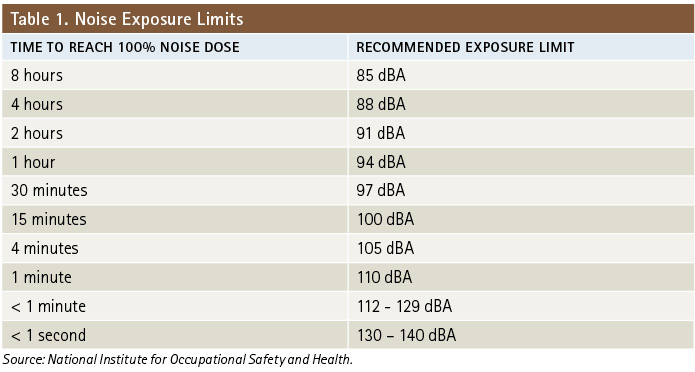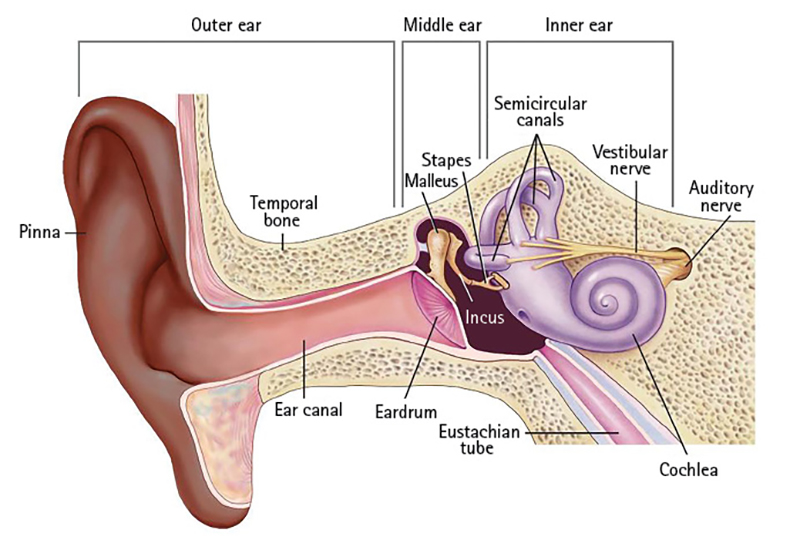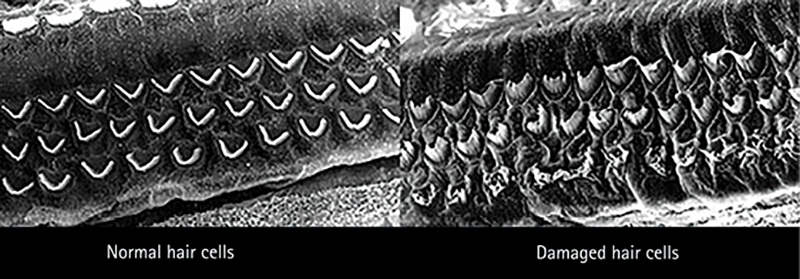By Connie Pignataro
Work-related noise-induced hearing loss (NIHL) is a long-time, underrated injury that is a cause of concern among fire service leaders. A University of Miami team is researching noise exposure in the fire service and exploring early warning systems and new diagnostics to improve the hearing health of firefighters.1
- “Can You Hear Me Now?”: Creating Controls to Avoid Hearing Loss
- Protect Your Hearing
- Fireground Noise Levels Give Sound Reasons For Hearing Protection
Firefighters face significant noise exposure, says Hillary Snapp, AuD, PhD, chief of audiology, associate professor in otolaryngology at the University of Miami Miller School of Medicine. “The inner ear structural and functional changes occur many years before becoming clinically evident and these changes can be more prevalent with years in the fire service.”1
Snapp says that these issues, combined with a lack of hazardous noise exposure awareness, not only lead to hearing loss but may potentially impact balance and cognitive functioning. According to its survey of 220 firefighters, 83% said that they never received any information about NIHL during training or conferences, and the topic is rarely discussed.1
The ability to hear and communicate on an emergency scene is critical to the safety of all involved; it could be the difference between life and death. A firefighter with hearing loss may not hear a distant moan or a cry for help during a search for victims or may not hear a firefighter’s activated personal alert safety system (PASS) device muffled by debris. Radio or face-to-face communication in a noisy environment may be nearly impossible for a firefighter with hearing loss; severe injury or death could result if he doesn’t hear an evacuation order.
The constantly changing, dynamic environment in which firefighters often work and the low priority that many firefighters place on hearing conservation complicate protecting firefighter hearing.2 The University of Miami study found that of the firefighters surveyed, 76% stated they were not concerned about future hearing loss.1
Every shift, firefighters are exposed to various levels of noise, much of it exceeding the recommended limits. According to the National Institute for Occupational Safety and Health (NIOSH), the exposure limit considered safe is 85 decibels (dBA) during an eight-hour period. Any noise above that level is considered hazardous; depending on the length of time, frequency, and intensity of exposure, it can cause temporary or permanent damage in one or both ears.3 Unprotected exposure of any duration should never exceed 140 dBA.4 In general, firefighters are exposed to short duration, high-intensity noise, but this exposure can vary greatly depending on the situation.2 Often, the permanent effects of noise are not recognized until it is too late (Table 1).
Possible Hazardous Noise Exposures
Apparatus Checkout
Firefighters often start the day by checking out and running all equipment on the apparatus, exposing themselves to varying degrees of noise. Since the fire apparatus engine will likely be running, it alone will produce an average of 80 dBA at idle to 87 dBA at high idle. Most firefighters have a personal radio that will measure approximately 87 dBA, as the volume will be louder while working around a running apparatus engine. Running circular and chain saws will expose a firefighter to approximately 105 dBA at maximum revolutions per minute, and a gasoline-powered positive-pressure ventilation fan will put out approximately 106 dBA. While all this is going on around the engine, the apparatus driver will be running the fire pump, adding between 85 and 97 dBA.5

Training
Firefighters participate in some form of training usually every shift. Training can range from computer and tabletop exercises with very little risk of noise exposure to activities using power tools and other loud equipment. Training likely to affect hearing includes search and rescue, vehicle extrication, forcible entry, charging and using hoselines, and any training involving noise-producing equipment.
Training in search and rescue of a down firefighter includes multiple noise exposures—e.g., power tools and one or more activated PASS devices to simulate a real-life incident. Those close to the activated device are exposed to 95 dBA.4 Hand tools such as an ax and halligan may be used for forcible entry, which could measure close to 150 dBA with each strike, similar to a hammer strike.6
In vehicle extrication training, members would be exposed to loud tools including reciprocating saws, generators, extrication tool power units, chisels, grinders, and truck engine noise, all of which produce between 110 and 120 dBA.2
Many times, training is slow, methodical, and repetitive, lengthening the duration of exposure to hazardous noise levels without hearing protection.
Call Response
Responding to calls is also a source of hazardous noise exposure. According to the National Fire Protection Association (NFPA), fire departments in the United States responded to nearly 37 million calls in 2020.7 Firefighters are notified through station alerting systems, which may be the old “school bell,” an electronic alerting system, or a radio alert tone. Depending on the alerting system’s volume, the opportunity for damaging noise is high. Measure and adjust the alerting system’s volume to reduce harmful noise exposure.
Next, truck engines start, and lights and sirens are activated. One study found firefighters are exposed to a decibel range of between 103 and 114 while riding in a fire apparatus. The sirens alone have been found to reach 120 dBA, well above the level considered to be damaging.2 Many firefighters attribute their hearing loss to the siren.
Since 1999, more than 4,000 firefighters across the country have filed lawsuits against Federal Signal, a company in Illinois that manufactures sirens, claiming that its sirens have permanently damaged their hearing. They stated that the siren and siren placement exposed firefighters to 120 dBA.8
To protect firefighters from damaging noise levels while riding in the cab, many departments have installed noise-attenuating headsets in their apparatus, which protect hearing and allow firefighters to hear the radio and communicate with each other. A popular brand used in the fire service provides a noise reduction rate of 23 dBA.9
On Scene
Depending on the scene, firefighters will continue to be exposed. A fire scene will include hazardous noise from power equipment, multiple fire apparatus engines, fire pumps, and radios. Working a vehicle accident on a busy highway will expose firefighters to approximately 90 dBA just from traffic noise.10 If extrication is involved, noise from generators, apparatus engines, radios, and power tools will add to the mix.
False Fire Alarms
False fire alarms are a common call for fire departments across the country. Firefighters responded to twice as many false fire alarms than they did actual fires in 2020, totaling more than 2.7 million calls.7 Fire alarm calls can be particularly damaging to the ears because the response involves accessing the fire alarm panel and walking the premises, all while the alarm is sounding.
According to NFPA 72, National Fire Alarm and Signaling Code®, the audible fire alarm volume must be set at 15 dBA above the ambient sound level or 5 dBA above the maximum sound level, not to exceed 110 dBA at the minimum hearing distance. NIOSH states that a worker can safely be exposed to 110 dBA for 1½ minutes.4 Since it generally takes more than 1½ minutes to investigate and get to the fire alarm panel to silence the alarm, firefighters are exposed to dangerous levels of noise nearly every time they respond to a fire alarm.
Hazmat Response
Firefighters respond to more than 700,000 hazardous materials calls every year, exposing them to dangerous chemicals, fires, and possible explosions.7 Some of those hazmat calls involve high-pressure gas line ruptures, which are dangerous not only because of the fire/explosion possibility but because the noise of such ruptures can produce 140 dBA, louder than a jet plane, and can permanently damage hearing.2 The ability to hear and communicate effectively on this type of call is critical for the safety of all involved.
Injury to the ears from exposure to loud noise is not the only concern researchers have noticed. One study found that noise levels between 90 dBA and 95 dBA increased bodily injury or near miss situations by 413%, and noise levels above 95 dBA produced a 500% greater risk of firefighters being injured on scene.11
The Elements of Hearing
It is important to understand how the delicate auditory system works. Vibrations or sound waves first reach the outer ear then travel through the ear canal into the middle ear. The sound vibrates the eardrum, which sends the vibrations to three tiny bones: the malleus, the incus, and the stapes. Next, the vibrations are sent to the cochlea in the inner ear. Inside the cochlea, tiny hair cells called stereocilia are normally straight but bend when exposed to sound, and the sound is transferred to the auditory nerve, which sends the sounds to the brain (Figure 1).12
Loud noise can temporarily or permanently damage one or multiple parts of the ear including the hair cells and membranes in the cochlea and the auditory nerve. Loud noise will cause the hair cells to bend to a greater degree. Sometimes the hair cells can recover from loud noise exposure like during a concert and will return to normal after a few hours or days. But if these hair cells are overworked, they will eventually die; 30 to 50% of the hair cells can die before a change in hearing is noticed (photo 1).13
Hearing loss is not the only effect that loud noise has on the human body. Temporary or permanent tinnitus (ringing in the ears) can develop. Damage from loud noise can also interfere with communication (both hearing and understanding) and create muscle tension, hypertension, or a sense of isolation. It can also cause fatigue and reduced efficiency and can lead to difficulty concentrating.14
According to Snapp, most firefighters are unaware that NIHL can also impact balance and cognitive functioning. Of those firefighters surveyed, 74% stated they were not concerned about losing their sense of balance. In fact, most of the firefighters stated that hearing loss was an expected consequence of the job.1
Solving the Problem
The best way to eliminate NIHL is to eliminate hazardous noise. Unfortunately, eliminating noise is not possible in the fire service working environment. As recommended by NFPA 1500, Standard on Fire Department Occupational Safety, Health, and Wellness Program, a hearing conservation program is a step in the right direction and must be a part of every fire department’s policies.15 A study conducted in 2005 found that fire departments that adhered to a hearing conservation program saw promising results, but more research is needed to understand the most effective components of those programs.2
Every hearing conservation program should include a hearing evaluation for every firefighter candidate and an annual evaluation as per NFPA 1582, Standard on Comprehensive Occupational Medical Program for Fire Departments.16 According to the University of Miami study, only 61% of those surveyed stated that they have had at least one hearing test in their lifetime.1
Policies, training, and hearing protection equipment may look good on paper, but expecting adherence to the policies and using the equipment may not be realistic. Getting firefighters to buy into using equipment to protect their hearing will be a tough sell.
The study at the University of Miami found that, in emergency settings, firefighters feel very strongly that using hearing protection reduces situational awareness and, at times, may be dangerous. They also found that 68% of firefighters are not concerned about hearing loss and consider it a consequence of working in the fire service.1
Figure 1. How We Hear

Source: National Institute on Deafness and Other Communication Disorders.
To change the culture, awareness and knowledge are the first steps, which must be followed by making effective and convenient tools available that are easy to use and will not inhibit situational awareness. That is easier said than done.
Many opportunities exist to use hearing protection—for example, during vehicle and equipment checkouts and routine maintenance, in the apparatus while driving to and from emergency scenes, and on fire alarm investigation calls where a fire alarm is sounding. The agency should also test the volume of the call notification system inside the station, ensuring that it is at a safe level.
The University of Miami study hopes to address some of these barriers along with early warning detection and behavior modification. A watch noise dosimeter application was one tool used to collect data for the study.1 Firefighters can use this app, which notifies the wearer with a tap on the wrist and a notification to the smartphone, when exposure levels may affect hearing. The wearer can also view his exposure level for a period of time, such as a 24-hour shift.17
Identifying when and where hazardous noise exposure may occur and providing the proper hearing protection are musts for any hearing conservation program.

(1) Photo by the Centers for Disease Control and Prevention.
NIOSH has also created a Sound Level Meter app for some smartphones that can be downloaded for free. NIOSH states that this app measures as accurately as professional instruments, and it can also collect data for researchers. Also, it will provide recommendations for selecting the proper hearing protection for the current environment along with other educational tools.18
The fire service has continued to create and improve on tools and equipment that allow firefighters to be more effective and safe—e.g., the halligan and respiratory protection. We must continue to be vigilant to keep ourselves healthy while we serve and into our retirement. We must consider protecting our hearing just as important as protecting our bodies from cancer and heart disease.
Recognizing unsafe noise levels and taking steps to protect our hearing with awareness, policies, and training must be the responsibility of everyone, from the individual to the fire chief. Leaders in the fire service must make solving the issue of NIHL a high priority so that hearing loss is not an expected consequence that we are forced to live with now and into our retirement.
Endnotes
1. Dean Henri R. Ford’s Interdisciplinary Research Seminar Series. Hazardous Noise and the Consequences of Hearing Health in the Fire Service. University of Miami. September 30, 2021.
2. Hong, PhD, RN, OiSaeng and Samo, PhD, FACOEM, Daniel G. Hazardous Decibels – Hearing Health of Firefighters. AAOHN Journal. August 2007. https://bit.ly/3s4kwD3.
3. National Institute on Deafness and Other Communication Disorders. Noise-Induced Hearing Loss. Retrieved October 27, 2021. https://bit.ly/3SfYCHv.
4. National Institute for Occupational Safety and Health. Occupational Noise Exposure. June 1998. https://bit.ly/3MGVDXE.
5. Lawson, J. Randall. PASS Sound Muffle Tests Using A Structural Firefighter Protective Ensemble Method. National Institute of Standards and Technology (NIST). July 2009. https://bit.ly/3yQZo73.
6. Brueck, MS, CIH, Scott E., Eisenberg, MD, MS Judith, Zechmann, MS, PE, INCE Bd. Cert., Edward, Murphy, PhD, William J., C. Morata, PhD, Thais, Krieg, PhD., Edward. Evaluation of Impact and Continuous Noise Exposure, Hearing Loss, Heat Stress, and Whole Body Vibration at a Hammer Forge Company. US Department of Health and Human Services. May 2016. https://bit.ly/3eBGxGr.
7. National Fire Protection Association. Fire Department Calls. Retrieved March 7, 2022. https://bit.ly/3D91lOZ.
8. Hajeli, Deepti & Briscoe, Tony. Chicago Tribune. Firefighters sue siren maker over hearing loss. December 21, 2015. https://bit.ly/3gd8y7w.
9. David Clark Company Inc. Use and Care Information. Retrieved on March 7, 2022. https://bit.ly/3VArhtS.
10. State of Illinois Department of Transportation. Highway Traffic Noise. Retrieved March 9, 2022. https://idot.illinois.gov/Assets/uploads/files/Doing-Business/Manuals-Guides-&-Handbooks/Highways/Design-and-Environment/Environment/Highway%20Traffic%20Noise%20—%20Noise%20Fundamentals%20111215.pdf.
11. Neitzel, Richard & Long, Rachel & Sun, Kan & Sayler, Stephanie & Thaden, Terry. Injury Risk and Noise Exposure in Firefighter Training Operations. Annals of Occupational Hygiene. 2015. https://bit.ly/3MJGB3w.
12. National Institute on Deafness and Other Communication Disorders. How Do We Hear? May 2015. https://bit.ly/3yKBydh.
13. Centers for Disease Control and Prevention. How Does Loud Noise Cause Hearing Loss? November 24, 2020. https://bit.ly/2NNTtql.
14. United States Department of Labor. OSHA Technical Manual. August 15, 2003. https://bit.ly/3gbgmGN.
15. National Fire Protection Association. NFPA 1500 (2021) Standard on Fire Department Occupational Safety, Health, and Wellness Program. https://bit.ly/3yQ3lsD.
16. National Fire Protection Association. NFPA 1582 (2022) Standard on Comprehensive Occupational Medical Program for Fire Departments. https://bit.ly/3Tx6Xb6.
17. Apple Watch User Guide. WatchOS 8.5. Retrieved 5/3/2022. https://apple.co/3s5JhyP.
18. National Institute for Occupational Safety and Health. NIOSH Sound Level Meter App. April 8, 2022. https://www.cdc.gov/niosh/topics/noise/app.html.
CONNIE PIGNATARO, CFEI, retired from the fire service in 2021 after more than 18 years of service. She served as a lieutenant firefighter/paramedic with Oakland Park (FL) Fire Rescue and later as a fire inspector/ investigator for Boynton Beach (FL) Fire Rescue. She has a bachelor of applied science degree in public safety administration.

